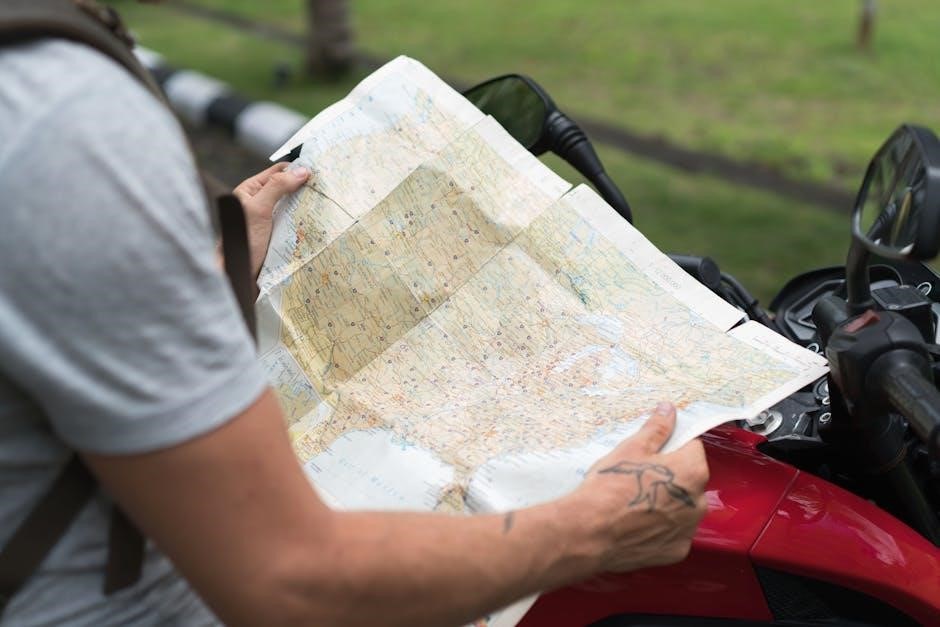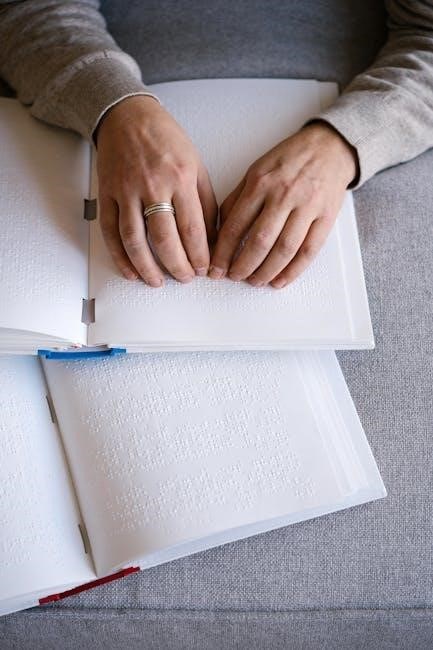Master the NY motorcycle permit test with this comprehensive study guide. It offers free practice tests, safety tips, and insights into legal requirements, ensuring a confident exam experience.
Overview of the Motorcycle Permit Test
The NY motorcycle permit test is a critical step for aspiring motorcyclists, assessing knowledge of road signs, traffic laws, and motorcycle-specific safety practices. The test consists of 20 questions, with a passing score of 14 correct answers (80%). Topics include safe riding techniques, legal requirements, and the dangers of alcohol and drugs. Preparation is essential, as the test covers both general driving rules and motorcycle-specific regulations. Utilizing the NY Motorcycle Manual and practice tests ensures a thorough understanding of the material. The test is designed to ensure riders are well-prepared for the challenges of motorcycling, emphasizing safety and responsible operation. Passing this test is the first step toward obtaining a motorcycle license in New York.
Importance of Proper Preparation
Proper preparation is crucial for success on the NY motorcycle permit test. The test evaluates your understanding of road safety, traffic laws, and motorcycle-specific regulations, requiring a thorough study of the NY Motorcycle Manual. Without adequate preparation, the risk of failing increases, delaying your ability to obtain a permit. Additionally, proper preparation ensures you understand critical safety practices, reducing accidents and enhancing your riding skills. Utilizing practice tests and study guides helps familiarize you with the test format and content, boosting confidence and knowledge. Preparation not only aids in passing the test but also equips you with essential skills for safe and responsible motorcycling.

Eligibility Criteria for the NY Motorcycle Permit
To qualify for a NY motorcycle permit, applicants must meet specific age, residency, and documentation requirements. Ensure you meet these criteria before applying to avoid delays.
Age Requirements
In New York, the age requirements for obtaining a motorcycle permit are structured to ensure safety and readiness. Applicants must be at least 16 years old to apply for a Class MJ junior motorcycle license, which is valid for riders under 18. Those 18 and older can apply for a Class M motorcycle license. For applicants under 18, parental or guardian consent is mandatory. Additionally, completing a state-approved Motorcycle Safety Foundation (MSF) course may reduce the minimum age for certain restrictions. Meeting these age criteria is essential to proceed with the application process and ensure compliance with state regulations. Proper documentation and proof of age are required.
Required Documentation
To apply for a New York motorcycle permit, specific documentation is required. Applicants must provide proof of identity, such as a valid passport or birth certificate, and a Social Security card or equivalent for verification. Additionally, proof of residency, like a utility bill or bank statement, is necessary. If under 18, parental consent is mandatory. Insurance documentation for the motorcycle is also required. The New York State Motorcycle Operators Manual, available online or at local DMV offices, is a critical resource for preparation. Ensuring all documents are accurate and up-to-date will streamline the application process. Proper documentation is essential to avoid delays and ensure compliance with state regulations.
Fees and Application Process
The fee for a New York motorcycle permit is currently $12.50, which includes a vision test and application processing. Applicants can submit their application online or in person at a local DMV office. The process begins with completing a Form MV-44, providing required documentation, and paying the associated fee. Once the application is approved, candidates can take the written knowledge test. If applying online, the test can be taken at home, with results submitted electronically. After passing, applicants must visit a DMV office to complete the process and obtain their permit. This streamlined approach ensures an efficient and convenient experience for aspiring motorcyclists.

The New York State Motorcycle Manual
The manual covers essential topics like road signs, traffic laws, and safety tips. It’s divided into sections on legal requirements, pre-ride checks, and safe riding practices. Use it to prepare for your test and learn safe motorcycling techniques.
Key Sections of the Manual
The New York State Motorcycle Manual is divided into six main sections, each focusing on critical aspects of motorcycling. The first section covers legal requirements for operating a motorcycle, including licensing, registration, and insurance. Another section details pre-ride protocols, emphasizing the importance of safety gear and equipment checks. The manual also dedicates a significant portion to safe riding practices, offering practical tips for navigating various road conditions. Additionally, it addresses the dangers of alcohol and drugs, highlighting their impact on riding abilities and legal consequences. Finally, it outlines the knowledge and skills tests required to obtain a motorcycle license, ensuring riders are fully prepared for both written and practical assessments.
Legal Requirements for Motorcyclists
In New York, motorcyclists must meet specific legal requirements to operate a motorcycle legally. A valid Class M (motorcycle) or Class MJ (junior operator) license is mandatory. Registration, inspection, and insurance for the motorcycle are also required. Motorcyclists must wear approved helmets and protective gear, including face/eye protection and durable clothing. Additionally, passengers must comply with safety regulations, and certain restrictions apply to junior operators. Familiarity with traffic laws and safety standards is essential to avoid penalties and ensure safe riding. These legal requirements are detailed in the New York Motorcycle Manual, a key resource for preparing for the permit test.
Pre-Ride Protocols and Safety Gear
Pre-ride protocols are crucial for motorcyclists to ensure safety before hitting the road. Riders must inspect their motorcycle’s essential components, such as tires, brakes, lights, and signals, to ensure proper functioning. Wearing appropriate safety gear is mandatory, including a Department of Transportation (DOT)-approved helmet, face or eye protection, and durable clothing like leather jackets and gloves. These protocols help minimize risks and prevent accidents. The New York Motorcycle Manual emphasizes the importance of these pre-ride checks and gear, highlighting their role in responsible and safe motorcycling practices. Adhering to these guidelines is essential for all riders in New York.
Safe Riding Practices and Techniques
Safe riding practices are essential for motorcyclists to navigate New York’s roads effectively. Key techniques include maintaining a safe following distance, adjusting speed according to road conditions, and using proper lane positioning. Riders should always be aware of their surroundings, anticipating potential hazards and the actions of other drivers. The New York Motorcycle Manual emphasizes the importance of defensive driving, such as signaling clearly and avoiding blind spots. Additionally, mastering skills like braking, cornering, and handling varying weather conditions is crucial. By adhering to these practices, motorcyclists can significantly reduce the risk of accidents and ensure a safe riding experience on New York roads.
The Dangers of Alcohol and Drugs
Operating a motorcycle under the influence of alcohol or drugs is extremely dangerous and illegal in New York. The legal blood alcohol limit for motorcyclists is 0.08%, and violating this can result in severe penalties, including license suspension and fines. Alcohol and drugs impair reaction times, judgment, and coordination, significantly increasing the risk of accidents. The New York Motorcycle Manual emphasizes that even small amounts of alcohol or drugs can affect a rider’s ability to control their vehicle. Fatigue and certain medications can also dangerously impair riding skills. Staying sober and alert is crucial for safe motorcycling, as motorcyclists are already more vulnerable on the road.
Knowledge and Skills Tests
To obtain a New York motorcycle permit, applicants must pass both a knowledge test and a skills test. The knowledge test consists of 20 multiple-choice questions based on the New York Motorcycle Manual, covering road signs, traffic laws, and safe riding practices. A passing score requires answering at least 14 questions correctly. The skills test evaluates practical riding abilities, such as balance, braking, and maneuvering. Preparation is key, as the manual and practice tests provide essential insights into the exam format and content. Mastering these tests ensures riders are well-prepared for safe and responsible motorcycling on New York roads.

Structure of the NY Motorcycle Permit Test
The NY motorcycle permit test includes 20 multiple-choice questions, requiring 14 correct answers to pass. It covers road signs, traffic laws, and motorcycle safety, with three answer choices per question.
Number of Questions and Passing Score
The NY motorcycle permit test consists of 20 multiple-choice questions. To pass, you must answer at least 14 questions correctly, achieving a score of 80%. Each question has three answer choices, focusing on road signs, traffic laws, and motorcycle safety. The test is designed to ensure a strong understanding of safe riding practices and legal requirements. Proper preparation using study guides and practice tests is essential to meet this threshold and obtain your permit. Understanding the format and content beforehand helps build confidence for the exam. Ensure you review all relevant materials to achieve the required score.
Types of Questions and Format
The NY motorcycle permit test features multiple-choice questions designed to assess knowledge of road signs, traffic laws, and motorcycle-specific safety practices. Questions are drawn from the New York Motorcycle Manual and cover topics such as safe riding techniques, legal requirements, and the dangers of alcohol and drugs. The test format includes clear instructions and straightforward language to ensure clarity. Additionally, the exam is available online, allowing applicants to take it from home before visiting the DMV. The format is consistent across all test instances, ensuring fairness and reliability. Understanding the question types and test structure helps applicants prepare effectively for the exam.
Time Allocation and Test Environment
The NY motorcycle permit test is designed to be completed efficiently, with no strict time limit, allowing applicants to answer questions at their own pace. The online format offers flexibility, enabling candidates to take the test from home before visiting the DMV. A calm and focused environment is crucial for optimal performance. The test platform is user-friendly, ensuring a smooth experience. Applicants can review questions and manage their time effectively. Familiarizing oneself with the test setup beforehand helps reduce anxiety. The relaxed format allows candidates to demonstrate their knowledge confidently, ensuring they are well-prepared for the challenges of safe motorcycling.

Study Resources for the NY Motorcycle Permit Test
Utilize free practice tests, the DMV handbook, interactive guides, and AI support to effectively prepare for the NY motorcycle permit test and ensure success.
Free Practice Tests and Simulators
Free online practice tests and simulators are essential tools for preparing for the NY motorcycle permit test. These resources mimic the actual exam format, featuring realistic questions and scenarios to help you assess your knowledge. Many websites offer interactive tests with immediate feedback, allowing you to identify and improve weak areas. Simulators provide a realistic experience, familiarizing you with the test environment and reducing anxiety. With unlimited attempts and updated content, these tools ensure you’re well-prepared. They cover critical topics like road signs, traffic laws, and motorcycle-specific safety rules, making them a valuable supplement to the DMV handbook. Use these resources to boost confidence and achieve success.

Importance of the DMV Handbook
The New York DMV handbook is the primary resource for preparing for the motorcycle permit test. It provides detailed information on road signs, traffic laws, and motorcycle-specific safety guidelines. The handbook is divided into key sections, including legal requirements, pre-ride protocols, and safe riding practices. It also covers critical topics like the dangers of alcohol and drugs while operating a motorcycle. Available in multiple formats, including PDF and audio versions, the handbook ensures accessibility for all learners. Regular updates keep the content current with New York’s DMV requirements. While practice tests are helpful, the handbook remains the most comprehensive and reliable source for understanding exam content and improving test performance.
Interactive Study Guides and AI Support
Enhance your NY motorcycle permit test preparation with interactive study guides and AI support. These tools offer dynamic learning experiences, such as audio versions of the manual and real-time assistance. AI chat can clarify complex topics and provide personalized feedback. Interactive guides adapt to your learning pace, offering tailored study plans. With features like progress tracking and focused practice sessions, these resources help you master the material efficiently. They complement traditional study methods, ensuring a well-rounded understanding of motorcycle safety and legal requirements. By leveraging technology, you can stay motivated and confident as you prepare for the test. These tools are designed to make learning convenient and effective.

Additional Resources for Motorcycle Safety
Explore the MSF courses, NYS Motorcycle Safety Program, and online training videos for enhanced motorcycle safety education and practical skills development.
Motorcycle Safety Foundation (MSF) Courses
The Motorcycle Safety Foundation (MSF) offers professional training for riders of all skill levels. These courses focus on real-world scenarios, teaching riders how to handle traffic situations effectively. The MSF curriculum includes both classroom and on-bike training, covering essential skills like braking, cornering, and collision avoidance. Designed for both new and experienced riders, MSF courses aim to enhance safety awareness and riding confidence. They are particularly beneficial for those preparing for the NY motorcycle permit test, as they emphasize practical knowledge and techniques. By completing an MSF course, riders can improve their abilities and reduce risks on the road. Visit MSF for more details.
New York State Motorcycle Safety Program
The New York State Motorcycle Safety Program, administered by the DMV, aims to enhance rider safety through education and training. It provides resources like the Motorcycle Manual, which covers legal requirements, pre-ride checks, and safe riding practices. The program emphasizes the dangers of alcohol and drugs while riding and prepares applicants for knowledge and skills tests. By focusing on practical knowledge and real-world scenarios, the initiative helps riders build confidence and reduce risks. This program is a valuable resource for those seeking to obtain a motorcycle permit or improve their riding skills in New York.
Online Training and Educational Videos
Supplement your studies with online training and educational videos designed to prepare for the NY motorcycle permit test. These resources provide interactive lessons, real-world scenarios, and visual explanations of road signs, traffic laws, and safety tips. Videos cover essential topics like pre-ride checks, safe riding techniques, and the dangers of impaired driving. Platforms offer audio versions and AI support for personalized learning. Online training mimics the actual test format, helping you build confidence and familiarity. By combining these tools with the Motorcycle Manual, you can ensure a well-rounded understanding of New York’s motorcycle regulations and improve your readiness for the exam.

Test Preparation and Strategies
Master the NY motorcycle permit test with effective strategies. Focus on understanding the manual, practicing with sample tests, managing anxiety, and staying updated on DMV requirements for success.
Understanding the Motorcycle Manual
Mastering the New York State Motorcycle Manual is crucial for success. The manual is divided into key sections, including legal requirements, pre-ride protocols, and safe riding practices. It emphasizes the importance of wearing protective gear, such as helmets and eye protection, and outlines the risks of alcohol and drug use while riding. The manual also covers essential skills and knowledge needed for the permit test, such as road signs, traffic laws, and safe maneuvering techniques. By thoroughly studying the manual, applicants can gain a deep understanding of motorcycle safety and regulations, ensuring they are well-prepared for both the written and practical tests. Utilize the manual’s interactive features, like quizzes and audio versions, to enhance your learning experience and retention of critical information.
Practicing with Sample Tests
Practicing with sample tests is an essential step in preparing for the NY motorcycle permit test. These tests simulate the actual exam format, helping you familiarize yourself with the question types and content. Many resources offer free practice tests that mirror the official exam, covering topics like road signs, traffic laws, and motorcycle-specific rules. By completing multiple practice tests, you can identify areas where you need improvement and refine your knowledge. Additionally, interactive tools like test simulators and AI-driven study guides provide personalized feedback, enhancing your learning experience. Regular practice not only boosts confidence but also ensures you’re well-prepared for the real test.
Managing Test Anxiety and Staying Focused
Managing test anxiety and staying focused is crucial for success on the NY motorcycle permit test. Deep breathing exercises, staying hydrated, and arriving early can help calm nerves. A structured study routine and positive mindset reduce stress. Practice tests familiarize you with the format, easing anxiety. Break study sessions into manageable parts to avoid overwhelm. Stay hydrated and ensure a good night’s sleep before the test. Positive affirmations and visualization techniques can boost confidence. Remember, preparation is key to staying focused and composed during the exam. By addressing anxiety proactively, you’ll approach the test with clarity and confidence, ensuring your best performance.

Staying Updated on NY DMV Requirements
Staying updated on NY DMV requirements is essential for a smooth motorcycle permit process. Regularly visit the official NY DMV website for the latest information on test formats, documentation, and legal changes. The NY Motorcycle Manual is frequently updated, so ensure you have the most recent version. Subscribe to DMV notifications or follow their social media for real-time updates. Additionally, online resources and practice tests often reflect the latest requirements, helping you stay informed. By keeping up with DMV updates, you can avoid surprises and ensure compliance with all regulations, making your permit application and test experience more efficient and stress-free.

Obtaining a New York motorcycle permit is a significant step toward becoming a licensed motorcyclist. By utilizing the NY Motorcycle Permit Test Study Guide, you can navigate the process with confidence. The guide provides a structured approach to understanding the Motorcycle Manual, practicing with sample tests, and staying updated on DMV requirements. Leveraging free practice exams, interactive study tools, and safety resources ensures thorough preparation. Remember, consistent study and adherence to safety protocols are key to passing the test and becoming a responsible rider. Stay focused, follow the outlined strategies, and you’ll be well-prepared to succeed in your motorcycle permit journey.